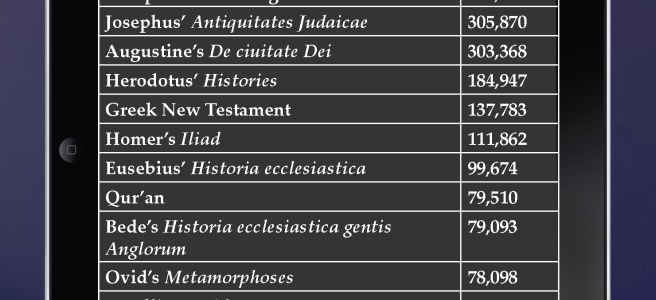A few years ago, I wrote a post about some preliminary experiments I ran using Optical Character Recognition (OCR) technology on medieval manuscripts. Fortunately, after I wrote that up, I had quite a bit of feedback from others who had used OCR with older printed books, and with languages like Latin and Greek. At one … Continue reading Forthcoming: “Modelling Medieval Hands: Practical OCR for Caroline Minuscule”
Category: Digital Humanities
The Afterlife of the Gospel of Pseudo-Matthew Preview
This post is essentially a teaser for my upcoming presentation at the International Congress on Medieval Studies in Kalamazoo next week. I'll be presenting a paper titled "The Afterlife of the Gospel of Pseudo-Matthew" on session 41, "The Scripturesque Middle Ages: Uses/Reception of Apocrypha along the Medieval North Sea," organized by Stephen Hopkins, in Sangren 1320, … Continue reading The Afterlife of the Gospel of Pseudo-Matthew Preview
Updating GitHub
Recently somebody I'm collaborating with on a project asked me if I had a GitHub repository. It came as a bit of a wake-up question for me. Why yes, I do, and I had mostly forgotten about it. In the back of my mind, I knew that my account was there, and I vaguely knew … Continue reading Updating GitHub
Opening Access in Medieval Studies
The recent launch of Parker Library on the Web to the public via a new platform signals big news for medieval studies at the start of 2018. This 10th-anniversary upgrade to 2.0 brings with it compatibility with the International Image Interoperability Framework (IIIF) and a Creative-Commons Non-Commercial License, so images and other data are available to use and download for … Continue reading Opening Access in Medieval Studies
Visualizing Networks of Anglo-Saxon Apocrypha
A while back, I had a twitter conversation about using network visualization tools online for studying the connections between medieval texts and manuscripts. After this exchange, I figured that others might be interested in seeing some of my work and, more specifically, how I went about it. My main interests in network visualizations so far … Continue reading Visualizing Networks of Anglo-Saxon Apocrypha
Getting Medieval in Virtual Reality
Last week I had my first fully immersive experience with virtual reality. I saw the future, and it is good. My experience came about because of the generosity of someone I recently met, Adam Blumenthal, the Virtual Reality Artist-in-Residence at Brown University. Because of my work on our common reading program at RIC, I had invited Adam … Continue reading Getting Medieval in Virtual Reality
Source Study in a Digital Age
Like many other medievalists, this past weekend I attended the International Congress on Medieval Studies at Western Michigan University in Kalamazoo. While there, I was privileged to present on a special session titled "Source Study: A Retrospective," sponsored by the Sources of Anglo-Saxon Culture (my thanks to Ben Weber for organizing and for including me). I was … Continue reading Source Study in a Digital Age
OCR and Medieval Manuscripts: Establishing a Baseline
Pseudo-Marcellus Passio Petri et Pauli in Modern Printed Edition and Weissenburg 48. [Edit: Interested in more about OCR with medieval manuscripts? Check out this more recent post.] Introduction Optical Character Recognition (OCR) software has increasingly been a part of scholarship, particularly in digital humanities. For example, it is fundamental to the Google Books project (which … Continue reading OCR and Medieval Manuscripts: Establishing a Baseline
Day of DH Posts
The Day of DH came and went this past Tuesday (April 8), and the internet was abuzz with people's activities. This year was the first time I got into the mix, since I found out about it only too late to participate last year. I spent my day with others at UConn who are interested in digital … Continue reading Day of DH Posts
Premodern Distant Reading? A Case of Hrabanus Maurus
One thing that I am continually interested in is how notions of "distant reading" (broadly understood) may be used to think about not only large corpora but also small corpora (as in my Judith project). A few weeks ago, I had a conversation with Yohei Igarashi (recently hired in English at UConn) about his work … Continue reading Premodern Distant Reading? A Case of Hrabanus Maurus






